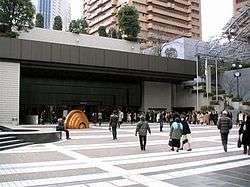Suntory Hall
The Suntory Hall (サントリーホール) is a concert venue in the central Akasaka district of Tokyo, Japan. Part of the Ark Hills complex, it consists of a main concert hall, widely considered one of the finest in the world for its acoustics — indeed Herbert von Karajan called it “a jewel box of sound” — and a smaller side-hall for chamber music. Its roof is an extended, tiered, landscape garden; the embassies of Spain, Sweden, and the United States are in the immediate vicinity. Construction began in the late 1970s and the facility opened in October 1986.
| Suntory Hall サントリーホール | |
|---|---|
 | |

| |
| General information | |
| Address | 1-13-1 Akasaka |
| Town or city | Minato, Tokyo |
| Country | Japan |
| Coordinates | 35°39′59.9″N 139°44′29″E |
| Opened | 1986 |
| Cost | ¥ 6,000 million |
| Owner | Suntory |
| Technical details | |
| Floor area | 12,027 m2 |
| Design and construction | |
| Architect | Yasui Architects |
| Other designers | Nagata Acoustics |
| Website | |
| Homepage | |
| References | |
| Factsheet | |
History
The Suntory Hall opened on 12 October 1986 in commemoration of the sixtieth anniversary of whisky production and twentieth of that of beer by Suntory.[1]
The Herbert von Karajan plaza in front of the Suntory Hall, which was constructed in April 1998, is in remembrance of the maestro, who was involved in the design of the hall[2] and who also recommended its vineyard style[3] as used at the Berliner Philharmonie, in which the audience surrounds the concert floor in the Main Hall. He also helped with its acoustical evaluation. Suntory was designed as a compromise hybrid seating layout, having substantially fewer acoustically-inferior seats sidewards and behind the stage than Berlin Philharmonie, incorporating elements of both the arena layout and vineyard style of the Berlin Philharmonie and classical shoeboxes like Vienna Musikverein. Apparently at the time of construction a visionary modification of the Berlin Philharmonie layout, since recent acoustic research clearly recognizes the advantage of the shoebox halls over Berlin Philharmonie architect Sharoun's unique idea of placing audience all around musicians, even if it meant that many sit in the acoustical offside with weak sound, away from the preferential directions many classical instruments and singers emit sound.[4][5] Architectural design was by Shoichi Sano, Yasui Architects and that of the acoustics by Minoru Nagata (Nagata Acoustics).[6][7]
The Suntory Hall has had performers and conductors from all around the world, including Karajan, Leonard Bernstein, Seiji Ozawa, Giuseppe Sinopoli, Claudio Abbado, Wolfgang Sawallisch, Hiroshi Wakasugi, Ivo Pogorelich, Mitsuko Uchida, and Hermann Prey.[8]
Performance and other facilities
Main Hall
The seats in the Main Hall are situated around the concert stage (250 m2 in 27 sections), with a capacity of 2,006 people.[1]
Also, the concert pipe organ, with 74 stops and 5,898 pipes, is located in the centre rear of the Hall. It is a large pipe organ, custom built and crafted by Rieger Orgelbau.[1] It has been modified with computerized control mechanisms to allow remote consoles to control it from the stage.
Small Hall
The seats of the Small Hall (also known as the Blue Rose) can be moved, and the stage consists of three different sections which can be raised by up to 60 centimeters in increments of 20 centimeters. It can seat 384 to 432 people.[1]
The interior 425 m2 (25 m x 17 m) consists of wooden paneling. The Hall's main function is for chamber music and solo recitals. Due to its size, (41.6 m2/62.4 m2 with 3 platforms), it has also been used for speeches, seminars and lectures.
Foyer
For enjoyment and relaxation while waiting for performances and during intermissions, the Foyer provides access to facilities such as the cocktail corner, as well as the "Bar Intermezzo" and "Cafe Intermezzo". Suntory Hall is the first to bring such facilities to Japan. In addition to the box office, there is also a gift shop and cloak room in the foyer.
Artworks in the hall include the Chandelier Symphony of Lights by Motoko Ishii, the stained glass “Growth of Grapes” by Keiko Miura, and wall art by Teppei Ujiyama which are all located in the foyer. Outside the main entrance is a sculpture by Takenobu Igarashi.
See also
| Wikimedia Commons has media related to Suntory Hall. |
References
- "Suntory Hall - Facilities". Suntory. Retrieved 4 March 2012.
- Chiho Iuchi (6 March 2009). "Suntory Hall in 'ruins' for Mozart production". The Japan Times. Retrieved 4 March 2012.
- Adams, Richard (2 July 2011). "Aspen Ideas Festival: How the vineyard style trumped the shoebox". The Guardian. Retrieved 4 March 2012.
- Pätynen, Jukka; Tervo, Sakari; Robinson, Philip W.; Lokki, Tapio (2014-03-25). "Concert halls with strong lateral reflections enhance musical dynamics". Proceedings of the National Academy of Sciences of the United States of America. 111 (12): 4409–4414. doi:10.1073/pnas.1319976111. ISSN 0027-8424. PMC 3970476. PMID 24591584.
- "https://www.sciencedaily.com/releases/2016/03/160323082708.htm". www.sciencedaily.com. Retrieved 2017-03-25. External link in
|title=(help) - "Welcome to SuntoryHall | SUNTORY HALL". www.suntory.com. Retrieved 2017-03-25.
- Hoffmann, Frank (2004-11-12). Encyclopedia of Recorded Sound. Routledge. ISBN 1135949492.
- "The brief history of Suntory Hall (1986 - 2010)" (PDF). Suntory. Retrieved 4 March 2012.